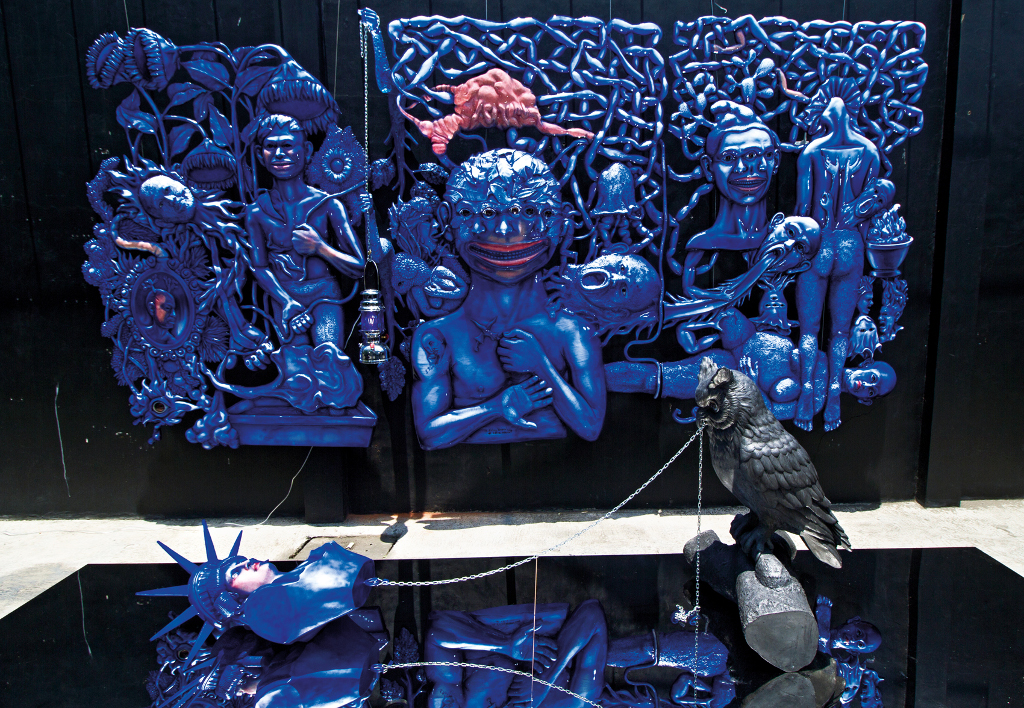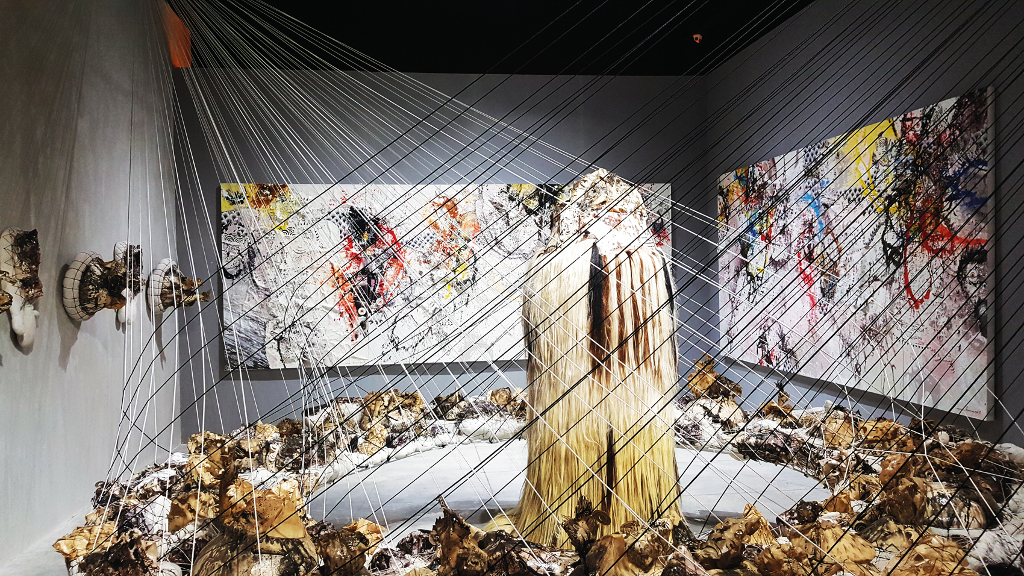The first Art Bali contemporary art exhibition was officially opened by the Minister of Finance of the Republic of Indonesia Sri Mulyani on the 9th of October in Nusa Dua. Held in conjunction with the 2018 annual meetings of the IMF-World Bank Group at Nusa Dua, Art Bali highlighted the works of 39 Balinese, Indonesian and foreign artists
 Sri Mulyana & Triawan Munaf Observing Art Works at Art Bali Image Curtesy Art Bali
Sri Mulyana & Triawan Munaf Observing Art Works at Art Bali Image Curtesy Art Bali
Global art events in Indonesia that present the finest local talent, attracting large national and international audiences, the media, collectors and the art industry have been a feature of the Java art landscape for over a decade. Art fairs, ArtJog and Art Jakarta have become crucial platforms and meeting points for the Indonesian art world – the event’s brands now securely positioned on the global art map.
The magnetism of Bali’s unique art and culture inspired the initial wave of intrepid western tourists to Bali, especially Ubud, in the 1920’s. The exceptional local creativity was the foundation of new economic models providing supplementary incomes for many Balinese. In villages around Ubud, for example, poor rice farmers became painters and woodcarvers producing souvenirs for the new burgeoning tourist markets.
Growing from a trickle to hundreds of visitors per month tourism boomed until 1945 and WWII and the Japanese invasion of Indonesia. In the 1970’s a next tourism phenomenon revitalised Bali’s economic woes, after an era that witnessed the ousting of the Dutch colonial government, 1963-64 Mt. Agung eruptions, famines and social and political uprising. Again art played a significant role with Balinese paintings finding new homes in countries throughout the world, while also gaining increasing national popularity.
The 2002 & 2004 Bali Bombings realised a dramatic slump in tourism heavily impacting the island. In 2008 lifestyle inspired events like the Bali Spirit Festival and the Ubud Writers & Readers Festival were initiated to stimulate tourism – both have since grown to become world leaders in their genres. Resort and lifestyle tourism has since boomed – yoga, self-development, detox and fine cuisine have attracted thousands of visitors to Ubud.
With the advent of the new digital economies outsiders partnering with the Balinese have capitalised on the new thriving tourism sectors. The lack of local initiative and know-how to build a dynamic and functional infrastructure has, however, resulted in art being almost forgotten within the island’s recent fortunes, with enormous social and financial potential being unrealised. The meeting of two creative minds, Heri Pemad, CEO and founder of ArtJog from Yogyakarta, and Balinese contemporary artist Made Aswino Aji, has been instrumental in creating a potential new starting point for the Bali art world that can open to exciting new horizons.
Themed “Beyond the Myths” Art Bali, which was closed 9 November, was set within a new, purpose built 1000 square meters facility. The AB•BC Building – Bali Collection, within the Nusa Dua tourism precinct was financed by the Indonesian Agency of Creative Economy (BEKRAF), the event taking more than two years of planning to be accomplished.
 AB – BC Bali Collection Building Nusa Dua, Bali. Image Richard Horstman
AB – BC Bali Collection Building Nusa Dua, Bali. Image Richard Horstman
According to Pemad the Indonesian government was driven to include an event within the IMF –World Bank side program, the meeting was attended by 34,000 delegations from around 200 countries, “They wished to challenge the ideas of delegates visiting Indonesia for the first time that Indonesia was still a traditional country. Through a presentation of contemporary art dialogue they could observe a nation in a process of development and change.”
“We are pushing Indonesian art onto the new map of the global creative economy,” said the Chairman of BEKRAF Triawan Munaf. “We are optimistic that the creative economy will become the backbone of the national economy.”

Entang Wiharso_Wisdom_Aluminum, car paint, polyurethane, resin, graphite, steel bar, lightbulb, electric cable, thread, color pigment, lamp, stainless steel, chain

Chusin Setiadikara – Jejak-Jejak Jalur Sutra 2017 150 x 200cm oil & acrylic on canvas – Image Richard Horstman

Nyoman Erawan – Dancing with the Shadows 2018 mixed media Image Richard Horstman

Filippo Sciascia 2018 mixed media Image Richard Horstman
Pemad brings eleven years of ArtJog experience to Art Bali and the new locally based event management team. “Our intention and commitment is to build and develop the eco system of art and culture in Bali,” Pemad stated. While adapting models implemented from ArtJog along with the trust from the national and local governments and participating stakeholders Art Bali has made the important steps in the journey to become a pivotal event. Bali Arts Roads (BAR), its supportive side program of more than 50 events throughout the island explored some of the diversity and richness of the local art scene, presented by Balinese, Indonesian and foreign contemporary artists.
 Ashley Bickerton – Yello Nose & Orange Nose , 2018 mixed media Image Richard Horstman
Ashley Bickerton – Yello Nose & Orange Nose , 2018 mixed media Image Richard Horstman
Given the right input Art Bali can evolve to become the focal point of the island’s art scene and new creative economy – providing a portal of information and opportunity to connect, educate and inspire, channeling international and domestic visitors, the media and the art world, new buyers and collectors directly to the source of art in Bali. Assisted by a growing and dynamic infrastructure and specialised art tourism, a sustainable art eco system is possible with economic gains to all stakeholders in the multi-level and multi-layered art landscape. Beneficiaries, of course will be the traditional artists of Bali.






